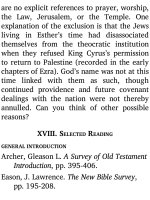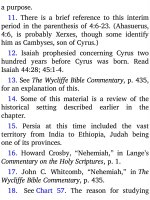Jensens survey of the old testament adam 253
Bạn đang xem bản rút gọn của tài liệu. Xem và tải ngay bản đầy đủ của tài liệu tại đây (198.89 KB, 4 trang )
history.
a) fall of Samaria (722 B.C., 1:6-7)
b) invasion of Judah by Sennacherib (702701 B.C., 1:9-16)
c) fall of Jerusalem, (586 B.C., 3:12; 7:13)
d) exile in Babylon, (586 B.C., 4:10)
e) return from captivity (c. 520 B.C., 4:18,13; 7:11,14-17)
f) birth of Jesus in Bethlehem (5:2)
4. Literary forms. Word pictures abound in
the book of Micah. Contrasts are prominent
(e.g., 3:9-12 and 4:1-5), and questions
appear often (1:5; 2:7; 4:9; 6:3,7,10,11;
7:10,18). Compare the rst question (1:5)
and the last (7:18).
5. Quoted in the Bible. Micah is quoted
three times in the Bible. Each occasion is
significant. Read the passages:
a) elders of Judah, quoting Micah 3:12 in
Jeremiah 26:18
b) magi, quoting Micah 5:2 in Matthew 2:56
c) Jesus, quoting Micah 7:6 in Matthew
10:35-36
II. SURVEY
1. Read the book
rst for overall
impressions.
2. Read the Bible text again, watching for
key words and phrases. For example, do you
observe any repeated words and phrases?
What word is common to these three verses:
1:2; 3:1; 6:1? Who is addressed in each
verse?
3. Study the opening verse of the book.
What is meant by “The word … which he
saw”? What was the subject of Micah’s
“visions,” according to this verse?
4. Compare the opening and closing verses
of the book. For example, compare 1:2 and
6:2.
5. Read each chapter, and record on paper
the main content of each. Which chapters
refer much to judgment, and which contain
promises?
6. Read 6:8 and 7:18. Why may these be
regarded as key verses for the book?
7. Study the survey Chart 107. Note that
the book of Micah is shown to be organized
around
three
main
collections
of
messages.13 Note the opening word of each,
“Hear.”
8. What three-part outlines appear on the
chart? According to these, how does Micah’s
theme progress throughout the book?
Compare the outlines with your own
observations of the book’s organization.
9. What pattern repeats itself in each of
the three parts? Mark this in your Bible,
scanning the text to justify such an outline.
10. Note the list of key words. Add to the
list the words you have observed.
III. APPLICATIONS









